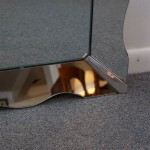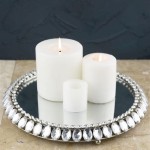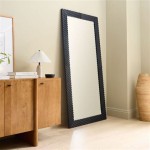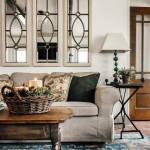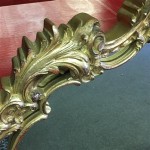```html
Mirrors On Walls Decor: Enhancing Space and Style
Mirrors, beyond their basic functional purpose, serve as powerful decorative elements capable of transforming interior spaces. Incorporating mirrors into wall decor can significantly impact a room's perceived size, brightness, and overall aesthetic appeal. The strategic placement and selection of mirrors offer a versatile approach to interior design, suitable for a wide range of styles and architectural layouts. This article explores the various ways mirrors can be effectively utilized as wall decor, examining the benefits they provide and the considerations involved in their application.
Expanding Perceived Space
One of the most significant advantages of using mirrors as wall decor is their ability to create the illusion of increased space. This is particularly beneficial in smaller rooms or areas with limited natural light. A large mirror placed on a wall reflects the opposite side of the room, effectively doubling the visual space. The reflected imagery tricks the eye, creating a sense of openness and airiness that is often lacking in confined environments. The size of the mirror directly correlates with the perceived increase in space; larger mirrors create a more dramatic effect.
The placement of the mirror is also crucial in maximizing this effect. Positioning a mirror across from a window is a particularly effective strategy, as it reflects the natural light and outdoor view, further enhancing the sense of spaciousness. In narrow hallways or corridors, a long, rectangular mirror placed along one wall can visually widen the space, making it feel less constricted. It is important to consider what the mirror will reflect, as a cluttered or unattractive reflection can negate the positive impact of the increased space.
Considerations for achieving optimal spatial illusion include the mirror's frame or lack thereof. Frameless mirrors offer a cleaner, more minimalist look that can further enhance the sense of openness, while ornate or heavily framed mirrors can draw attention to themselves and potentially detract from the overall effect. The choice depends on the desired aesthetic and the existing decor of the room.
Enhancing Natural and Artificial Light
Mirrors are highly effective at reflecting both natural and artificial light, making them valuable assets in rooms that suffer from poor illumination. By strategically positioning mirrors to capture and redirect light, it is possible to brighten up dark corners and create a more welcoming and vibrant atmosphere. This is particularly useful in areas with limited windows or where natural light is obstructed.
When utilizing mirrors to enhance natural light, consider placing them near windows or other sources of daylight. The mirror will capture the incoming light and reflect it back into the room, effectively increasing the overall brightness. The angle of the mirror can be adjusted to direct the light towards specific areas that need more illumination. In rooms with only one window, a mirror placed opposite the window can help to distribute the light more evenly throughout the space.
Mirrors can also be used to amplify artificial light sources. Placing a mirror behind a lamp or chandelier will enhance the light output, creating a more dramatic and visually appealing effect. This technique is particularly effective in dining rooms or living rooms where creating a warm and inviting ambiance is desirable. When using mirrors to enhance artificial light, it is important to consider the type of light fixture being used, as certain types of light can create unwanted glare or reflections.
The size and shape of the mirror also play a role in its ability to reflect light. Larger mirrors will naturally reflect more light than smaller mirrors, while mirrors with curved or angled surfaces can help to distribute the light more evenly. Ultimately, the best approach is to experiment with different mirror placements and angles to determine what works best in a particular space.
Adding Style and Aesthetic Appeal
Beyond their functional benefits, mirrors serve as versatile decorative elements capable of adding style and aesthetic appeal to any room. Mirrors are available in a wide range of shapes, sizes, frame styles, and finishes, allowing for considerable customization to complement diverse interior design preferences. The right mirror can serve as a focal point, add visual interest, and tie together the overall aesthetic of a space.
The frame of a mirror plays a significant role in its overall aesthetic impact. Ornate or antique frames can add a touch of elegance and sophistication, while sleek, modern frames offer a more minimalist and contemporary look. Frameless mirrors provide a clean and understated appearance, allowing the reflected image to take center stage. The choice of frame depends on the desired style and the existing decor of the room.
The shape of the mirror can also influence its decorative effect. Round mirrors can soften the edges of a room and create a more harmonious feel, while rectangular mirrors can add a sense of structure and formality. Geometric shapes, such as squares or hexagons, can introduce a modern and artistic element. The selection of shape should consider the overall design scheme and the desired visual impact.
Mirrors can also be used to create interesting visual effects and add depth to a room. A gallery wall of small mirrors can create a dynamic and eye-catching display, while a large statement mirror can serve as a dramatic focal point. Mirrors can also be used to highlight architectural features or artwork, drawing attention to specific areas of the room.
Different types of mirrors can also offer distinct aesthetic qualities. Antique mirrors, with their distressed or aged appearance, can add character and charm to a space. Tinted mirrors, such as those with a bronze or silver finish, can create a warmer and more luxurious ambiance. The choice of mirror type should complement the overall design style and the desired mood of the room.
Strategic Placement Considerations
The strategic placement of mirrors is paramount to maximizing their aesthetic and functional benefits. Improper placement can diminish the intended effect or even create undesirable visual outcomes. Careful consideration should be given to what the mirror reflects, the surrounding decor, and the overall layout of the room.
Avoid placing mirrors in areas that reflect clutter or unattractive views. A mirror that reflects a pile of laundry or a messy corner will only amplify the visual disorder, negating the positive impact of the added space and light. Instead, position mirrors to reflect attractive features, such as artwork, plants, or well-organized areas of the room.
Consider the height at which the mirror is mounted. For functional purposes, such as in a bathroom or entryway, the mirror should be placed at a height that allows for comfortable viewing. For decorative purposes, the height can be adjusted to create different visual effects. A mirror mounted higher on the wall can create a sense of height and grandeur, while a mirror placed lower on the wall can create a more intimate and grounded feel.
Be mindful of the potential for glare or unwanted reflections. Avoid placing mirrors directly opposite windows or other sources of bright light, as this can create distracting glare that is uncomfortable to the eye. Adjust the angle of the mirror to minimize glare and maximize the diffusion of light.
In small rooms, avoid using too many mirrors, as this can create a disorienting and claustrophobic effect. While mirrors can create the illusion of increased space, using too many can overwhelm the eye and make the room feel smaller than it actually is. Choose a few strategically placed mirrors to maximize the benefits without creating a sense of visual chaos.
The surrounding decor should also be considered when placing mirrors. The style and color of the mirror frame should complement the existing decor of the room. Avoid clashing styles or colors that can create a discordant visual effect. Integrate the mirror seamlessly into the overall design scheme to create a cohesive and harmonious look.
Finally, consider the layout of the room when placing mirrors. In narrow hallways or corridors, a long, horizontal mirror can visually widen the space. In rooms with low ceilings, a tall, vertical mirror can create the illusion of height. Adapt the placement of mirrors to the specific characteristics of the room to optimize their impact.
```
Pin On Home Style And Design

Beautiful Mirror Decoration Ideas Living Room Mirrors Decor Wall

Mirror Decoration For Home 15 Ideas To Decorate With Mirrors

5 Decorative Wall Mirrors For Your Home Designcafe

10 Most Stylish Wall Mirror Designs To Adorn Your Modern Home Decor Living Room Contemporary Mirrors

Silver Acrylic Hexagon Wall Decor Mirrors Set Of 6 Pyari Walls

Water Drop Decorative Mirrors Wall Decor Mirror Available In 3 Colors By Mdm Dizayn

Frame Material Metal Decorative Wall Mirror

Handmade Wall Mirrors Art Artwork Iron Hanging For Home Dining Room Bathroom Farmhouse Decor Ginkgo Leaf Com
.jpg?strip=all)
9 Benefits That Make Wall Mirror A Must Have For Your Home Myarticles



